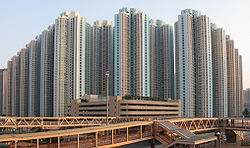
So we finally get the confirmation that the government will restart the Home Ownership Scheme (HOS). The HOS began in 1970 as a subsidized-sale programme of public housing that aims to give the poor a chance to purchase as well as rent public housing from the government. Under the scheme, the government sells apartments to eligible low-income residents at prices far below the overall market and also provides subsidies on the land value. It restricts reselling of the units in the second-hand market to low-income residents. The HOS was suspended in 2003 after property values collapsed.
The government will resume the controversial HOS programme in a new form. Monthly household income eligibility will be HK$30,000 or below, and income level which would (in the current market anyway) have difficulties to own a property in the private sector. The flats will mostly be small sized (100 to 200 sq. feet). The pricing is based on the affordability of these households at the market situation at that moment (which, supposedly, will be dependent on the mortgage interest rates and other factors). The current estimate offered by the government is HK$1.5 to 2 million. The first batch of 2,500 flats will be available for presales in 2014 or 2015. Over the 4 year period from 2016-17, the government will be providing a total of 17,000 or more, with the annual supply between 2,500 to 6,500 units.
Another new feature for the scheme is that the flats will be available for secondary transactions in 5 years time with a slightly different requirement for premium. As in the past, the owners will have to pay premium as the flats are sold in the private market, and the premium is an adjustable contingent on the prevailing market condition. But in the new HOS, the premium will be regarded as a loan to the owner, thus the premium payment will be based on the subsidy the government made at the time of purchase. Thus the premium will not be subjected to adjustment as in the old HOS.
For those households who are earning HK$40,000 a month or more, there is the My Home Purchase Plan announced last year. There will be 5,000 of such flats coming on stream, with 1,000 of them in Tsing Yi coming onto the market in 2014. On top of that, the government continues to pledge to supply land available for 20,000 units for the private sector each year in the next decade, and an average of 15,000 new units per year in public rental housing.
To assess the impact, paragraph 8 of the policy address is useful (emphasis mine):
8. Housing is an issue of great public concern. The joint efforts of the Government and our people over the past decades have produced good results in this area. There are currently 2.6 million residential units in Hong Kong, accommodating 2.35 million households. Of those, 730 000 households live in public rental housing (PRH) and 380 000 in self-owned units acquired with government subsidies. In other words, almost half of the households in Hong Kong are benefiting from some form of housing subsidy by the Government. Of the 1.24 million households living in private properties, 870 000 are owner-occupants. Taken together, nearly 85% of households live in PRH units, subsidised home ownership scheme flats or their own private properties.
As far as the total housing stock is concerned, there is no shortage whatsoever. Based on my previous estimates, the private sector housing stock consists of about 1.4 million units, and this housing stock is accommodating 1.24 million households, of which 870,000 own the flats they are living in. That means there is surplus supply available in the housing stock.
Based on the population growth and households formation estimates, with 15,000 annual supply of flats in the public rental housing, my previous estimates suggest that the private sector market would need roughly net 13,000-15,000 units of annual supply to maintain the supply-and-demand balance, assuming that half of the new households will choose to live in private housing. Without HOS, however, we would need more supply in the private sector, for sure. The estimation is not wholly scientific, but 15,000 –20,000 units of net private sector supply for the next 5 years or so should be sufficient if HOS is not available. And given the recent sub-10,000 gross units supply, it would also be desirable to have more supply in the near-term. So 20,000 units of gross new supply per year could be sufficient (there are demolitions of old buildings happening every year, with the exact figures not clear, the net supply would be slightly less than the gross).
The new HOS supply of 2,500 to 6,500 units per year, together with the My Home Purchase Plan, do not appear to be large enough to alter the balance of supply and demand, at least in the near-term, especially considering the fact that it will take at least 3 years for those supply to come onto the market. Thus, the announcement today does not offer anything dramatic in terms of altering the supply-and-demand balance. Of course, with population growth slowing and population ageing, the supply level of 20,000 flats in the private sector, roughly 5,000 HOS and My Home Purchase Plan flats per year, and 15,000 public rental units per year, would probably be more problematic in the a more distant future. The key for the government in 5-10 years ahead will be flexibility.